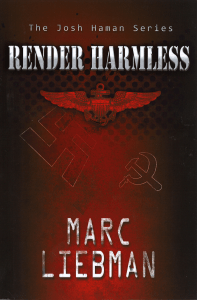 By Marc Liebman, Fireship Press Tucson, (2014)
By Marc Liebman, Fireship Press Tucson, (2014)
Reviewed by Charles H. Bogart
This is the second book in the author’s Lt. Josh Haman USN series. The first book, Big Mother 40, was set in Vietnam. In that book, Lt. Haman was a USN helicopter pilot. Lt Haman is once again the central character in Render Harmless. The book is set in 1973, while Lt. Haman is serving as an exchange pilot with the Royal Navy Fleet Air Arm. Many Americans have unfortunately forgotten that the 1970’s was an era of terrorist attacks upon the United States, Israel, and NATO members by a number of terrorist organizations. These terrorist groups ranged from the far right to the far left, but most were supported either indirectly by the Soviet Union or directly by the East German government.
The main antagonist in Render Harmless is a terrorist group that calls itself the “Red Hand.” The members of this organization are former members of the Nazi Party who are seeking to form The Fourth Reich. Their political agenda calls for the use of improvised explosive devices to sow fear among West Germans and cause them to lose faith in their present government. While the main targets of these bombs are Americans and Jews, the perpetuators quickly justify the fact that these attacks kill innocent German bystanders. German inncoents are part of the price German society must bear for achieving a greater good, a Germany free of foreigners and people of Jewish descent. With this accomplished, Germany would once again reign as a military, economic, and political powerhouse dominating the world scene.
When the West German government law enforcement agencies proved incapable of stopping members of the Red Hand from carrying out terrorist attacks, Navy Seal Team Six is given orders to use any means necessary to render the Red Hand harmless. The story takes place during height of the Cold War, and the author captures the fact that within the Cold War a dirty hot war was being fought where innocent people were killed in order to bring about a group’s desired change in society. This was an unconventional war in which the adage, “the enemy of my enemy is my friend,” rang true. Within the story, the reader confronts the fact that terrorist groups with totally different agendas can and do band together to attack a common enemy. Thus, part of the central theme in the story is the Communist Party supporting a Nazi movement they hope will destabilize NATO.
The author crafts a reasonable story of why a resurgent Nazi movement is born in Germany and how it attracts the support of Arab extremist and the East German government. In turn, the author provides an excellent explanation as to why the resurgent Nazi movement is willing to work hand in glove with the East German Communist government and vice versa. Both sides are sure that they are in control of the current political scene and that they will be able to crush the other side once their overall goal is achieved.
The tale of how the perpetuators are discovered and tracked to their lair is reasonable. However, the manner in which the “bad guys” are taken out crosses the line from reality to James Bond spy story. Nevertheless, the story line flows freely, carrying the reader along at a nice pace. Particularly interesting is how the political fallout from the smashing of the terrorist plot plays out among all the contenders within the affair. In the closing scene, both sides total their loses and wins. Based upon this calculation, they reward or punish their players in this deadly game.
The book is a great read with just the right amount of solid historical background to make the story believable to those who lived through the Cold War. Treat yourself to a nice weekend read and purchase a copy of this book. I am looking forward to the next book on the adventures of Lt. Josh Haman.
Charles H. Bogart is a frequent contributor to Naval History Book Reviews.

